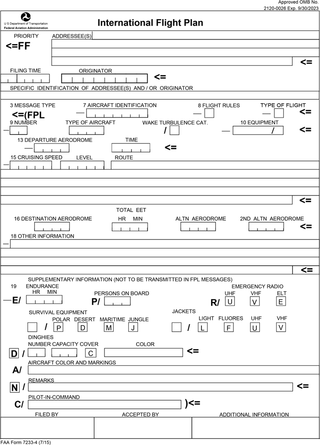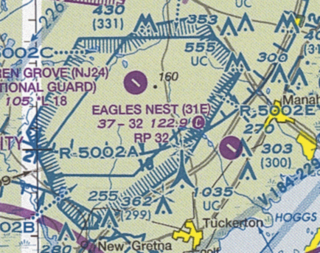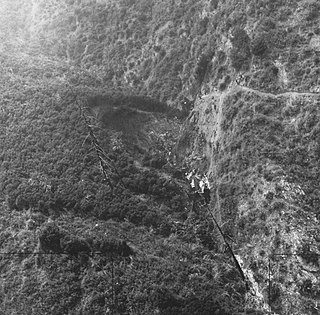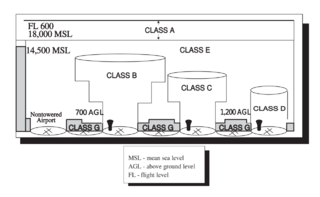Description
Military Training Routes are divided into Instrument Routes (IR), and Visual Routes (VR). Each route is identified by either of these two letters, followed by either four digits for routes below 1,500 feet above ground level, or three digits for routes extending for at least one leg above 1,500 ft AGL. (i.e., VR-1056). The difference between the IR and VR routes is that IR routes are flown under Air Traffic Control, while VR routes are not.
Airspace above the United States from the surface to 10,000 feet above sea level is limited to 250 knots (indicated airspeed) per the FAA's Federal Aviation Regulations. This speed limit hinders most modern-day tactical aircraft training operations, since low-level strikes are conducted almost exclusively at speeds exceeding 300 knots. Military Training Routes are usually limited to 420 knots, and in no case are aircraft allowed to exceed Mach 1 within United States sovereign airspace, except in designated Military Operation Areas. While on the route military aircraft squawk a Mode C Transponder code of '4000', which informs controllers that they are 'speeding' on a route. This squawk however is only legal by military aircraft, while inside a properly scheduled route corridor. MTRs do not constitute an official airspace, and are all open to VFR or IFR civilian traffic; however only military aircraft are allowed to squawk 4000 and exceed 250 knots.
Each route is defined by a number of geographical coordinates and their respective navaid fixes. From this line the corridor is extended a specific number of miles, in the vast majority of cases this is five miles, making the corridor 10 miles wide. The Routes are individually operated through one of the local military air bases, which schedule and 'own' the route. The FAA requires these bases to 'NOTAM' out the routes at least two hours prior to use to allow for civilian traffic to de-conflict if needed.....

In aviation, instrument flight rules (IFR) is one of two sets of regulations governing all aspects of civil aviation aircraft operations; the other is visual flight rules (VFR).
In aviation, visual flight rules (VFR) are a set of regulations under which a pilot operates an aircraft in weather conditions generally clear enough to allow the pilot to see where the aircraft is going. Specifically, the weather must be better than basic VFR weather minima, i.e., in visual meteorological conditions (VMC), as specified in the rules of the relevant aviation authority. The pilot must be able to operate the aircraft with visual reference to the ground, and by visually avoiding obstructions and other aircraft.
The Federal Aviation Regulations (FARs) are rules prescribed by the Federal Aviation Administration (FAA) governing all aviation activities in the United States. The FARs comprise Title 14 of the Code of Federal Regulations (CFR). A wide variety of activities are regulated, such as aircraft design and maintenance, typical airline flights, pilot training activities, hot-air ballooning, lighter-than-air aircraft, man-made structure heights, obstruction lighting and marking, model rocket launches, commercial space operations, model aircraft operations, Unmanned Aircraft Systems (UAS) and kite flying. The rules are designed to promote safe aviation, protecting pilots, flight attendants, passengers and the general public from unnecessary risk.
Airspace is the portion of the atmosphere controlled by a country above its territory, including its territorial waters or, more generally, any specific three-dimensional portion of the atmosphere. It is not the same as outer space which is the expanse or space outside the Earth and aerospace which is the general term for Earth's atmosphere and the outer space within the planet's vicinity. History:

In the United States, airways or air routes are defined by the Federal Aviation Administration (FAA) in two ways:

Flight plans are documents filed by a pilot or flight dispatcher with the local Air Navigation Service Provider prior to departure which indicate the plane's planned route or flight path. Flight plan format is specified in ICAO Doc 4444. They generally include basic information such as departure and arrival points, estimated time en route, alternate airports in case of bad weather, type of flight, the pilot's information, number of people on board, and information about the aircraft itself. In most countries, flight plans are required for flights under IFR, but may be optional for flying VFR unless crossing international borders. Flight plans are highly recommended, especially when flying over inhospitable areas such as water, as they provide a way of alerting rescuers if the flight is overdue. In the United States and Canada, when an aircraft is crossing the Air Defense Identification Zone (ADIZ), either an IFR or a special type of VFR flight plan called a DVFR flight plan must be filed. For IFR flights, flight plans are used by air traffic control to initiate tracking and routing services. For VFR flights, their only purpose is to provide needed information should search and rescue operations be required, or for use by air traffic control when flying in a "Special Flight Rules Area."
The world's navigable airspace is divided into three-dimensional segments, each of which is assigned to a specific class. Most nations adhere to the classification specified by the International Civil Aviation Organization (ICAO) and described below, though they might use only some of the classes defined below, and significantly alter the exact rules and requirements. Similarly, individual nations may also designate special use airspace (SUA) with further rules for reasons of national security or safety.

In aviation, an instrument approach or instrument approach procedure (IAP) is a series of predetermined maneuvers for the orderly transfer of an aircraft operating under instrument flight rules from the beginning of the initial approach to a landing, or to a point from which a landing may be made visually. These approaches are approved in the European Union by EASA and the respective country authorities and in the United States by the FAA or the United States Department of Defense for the military. The ICAO defines an instrument approach as, "a series of predetermined maneuvers by reference to flight instruments with specific protection from obstacles from the initial approach fix, or where applicable, from the beginning of a defined arrival route to a point from which a landing can be completed and thereafter, if landing is not completed, to a position at which holding or en route obstacle clearance criteria apply."

Trans World Airlines (TWA) Flight 553 was a McDonnell Douglas DC-9-15 jet airliner, registration N1063T, operated by Trans World Airlines on March 9, 1967 between Pittsburgh, Pennsylvania and Dayton, Ohio. While descending toward Dayton about 29 miles from the airport, the flight collided in midair with a Beechcraft Baron, a small, general-aviation airplane, near Urbana, Ohio. All 25 aboard the DC-9 and the sole occupant of the Beechcraft were killed.

Restricted airspace is an area of airspace typically used by the military in which the local controlling authorities have determined that air traffic must be restricted or prohibited for safety or security concerns. It is one of many types of special use airspace designations and is depicted on aeronautical charts with the letter "R" followed by a serial number.

Allegheny Airlines Flight 853 was a regularly scheduled Allegheny Airlines flight from Boston, Massachusetts, to St. Louis, Missouri, with stops in Baltimore, Maryland, Cincinnati, Ohio, and Indianapolis, Indiana. On September 9, 1969, the aircraft serving the flight, a McDonnell Douglas DC-9, collided in mid-air with a Piper PA-28 light aircraft near Fairland, Indiana. The DC-9 was carrying 78 passengers and 4 crew members, and the Piper was leased to a student pilot on a solo cross-country flight. All 83 occupants of both aircraft were killed in the accident and both aircraft were destroyed.
A military operations area (MOA) is an airspace established outside Class A airspace to separate or segregate certain nonhazardous military activities from IFR Traffic and to identify for VFR traffic where these activities are conducted. Similar structures exist under international flight standards. These are designed for routine training or testing maneuvers. Areas near actual combat or other military emergencies are generally designated as restricted airspace. See Temporary Flight Restriction (TFR).

A transponder is an electronic device that produces a response when it receives a radio-frequency interrogation. Aircraft have transponders to assist in identifying them on air traffic control radar. Collision avoidance systems have been developed to use transponder transmissions as a means of detecting aircraft at risk of colliding with each other.

Hughes Airwest Flight 706 was a regularly scheduled flight operated by American domestic airline Hughes Airwest from Los Angeles, California to Seattle, Washington, with several intermediate stops. On Sunday, June 6, 1971, the McDonnell Douglas DC-9 serving as Flight 706 departed Los Angeles just after 6 p.m. en route to Seattle as a McDonnell Douglas F-4 Phantom II of the United States Marine Corps was approaching Marine Corps Air Station El Toro near Irvine, California at the end of a flight from Naval Air Station Fallon in Nevada. The two aircraft collided in midair over the San Gabriel Mountains near Duarte, California, killing all passengers and crew on the DC-9 as well as the F-4's pilot. The F-4's radar intercept officer survived.

The United States airspace system's classification scheme is intended to maximize pilot flexibility within acceptable levels of risk appropriate to the type of operation and traffic density within that class of airspace – in particular to provide separation and active control in areas of dense or high-speed flight operations.

In air traffic control, separation is the name for the concept of keeping an aircraft outside a minimum distance from another aircraft to reduce the risk of those aircraft colliding, as well as prevent accidents due to secondary factors, such as wake turbulence. Separation can also apply to terrain, obstacles, and controlled airspace, wherein an aircraft must stay at a minimum distance from a block of airspace; as an example, all aircraft must be approved by the controller who "owns" the airspace before the aircraft is approved to enter that sector.
In United States aviation, a special flight rules area (SFRA) is a region in which the normal regulations of flight do not apply in whole or in part, especially regulations concerning airspace classification, altitude, course, and speed restrictions, and the like.

On August 8, 2009, at 11:53 a.m. (15:53 UTC), nine people died when a tour helicopter and a small private airplane collided over the Hudson River near Frank Sinatra Park in Hoboken, New Jersey, United States. The aircraft were in an area known as the "Hudson River VFR Corridor", which extends from the surface of the river to altitudes of 800 to 1,500 ft at various locations along the Hudson River in the immediate area of New York City. Within this corridor, aircraft operate under visual flight rules (VFR), under which the responsibility to see and avoid other air traffic rests with the individual pilots rather than with the air traffic controller.

Ozark Air Lines Flight 965 was a scheduled commercial flight from Chicago, Illinois, to Lambert Field in St. Louis, Missouri, with a scheduled intermediate stopover at Greater Peoria Regional Airport in Peoria, Illinois. On March 27, 1968, the Douglas DC-9-15 jetliner operating the flight, carrying 44 passengers and five crew, collided in mid-air with a single-engined Cessna 150F while both aircraft were on approach to the same runway at Lambert Field. The DC-9 landed safely with no injuries to any of its 49 occupants, while both pilots in the two-person Cessna died in the collision and subsequent ground impact.












